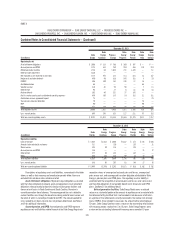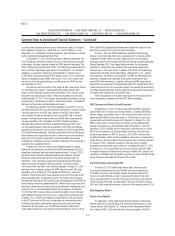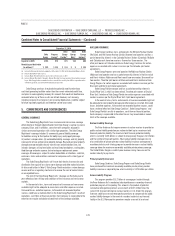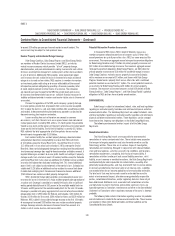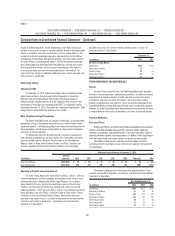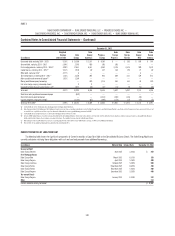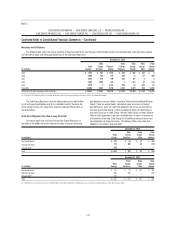Duke Energy 2014 Annual Report Download - page 149
Download and view the complete annual report
Please find page 149 of the 2014 Duke Energy annual report below. You can navigate through the pages in the report by either clicking on the pages listed below, or by using the keyword search tool below to find specific information within the annual report.
129
PART II
DUKE ENERGY CORPORATION • DUKE ENERGY CAROLINAS, LLC • PROGRESS ENERGY, INC. •
DUKE ENERGY PROGRESS, INC. • DUKE ENERGY FLORIDA, INC. • DUKE ENERGY OHIO, INC. • DUKE ENERGY INDIANA, INC.
Combined Notes to Consolidated Financial Statements – (Continued)
December 31, 2014
Duke
Energy
Progress
Energy(b)
Duke
Energy
Florida(b)
Duke
Energy
Ohio(c)
Duke
Energy
Indiana(d)
Capacity (in MW) 1,704 873 873 163 668
Remaining net book value
(in millions)(a) $ 239 $ 114 $ 114 $ 9 $ 116
(a) Included in Net property, plant and equipment as of December 31, 2014, on the Consolidated Balance Sheets.
(b) Includes Crystal River Units 1 and 2.
(c) Includes Miami Fort Unit 6 which is expected to be retired by June 1, 2015.
(d) Includes Wabash River Units 2 through 6. Wabash River Unit 6 is being evaluated for potential conversion
to gas. Duke Energy Indiana committed to retire or convert these units by June 2018 in conjunction with a
settlement agreement associated with the Edwardsport air permit.
Duke Energy continues to evaluate the potential need to retire these
coal-fi red generating facilities earlier than the current estimated useful lives,
and plans to seek regulatory recovery for amounts that would not be otherwise
recovered when any of these assets are retired. However, such recovery,
including recovery of carrying costs on remaining book values, could be subject
to future regulatory approvals and therefore cannot be assured.
5. COMMITMENTS AND CONTINGENCIES
GENERAL INSURANCE
The Duke Energy Registrants have insurance and reinsurance coverage
either directly or through indemnifi cation from Duke Energy’s captive insurance
company, Bison, and its affi liates, consistent with companies engaged in
similar commercial operations with similar type properties. The Duke Energy
Registrants’ coverage includes (i) commercial general liability coverage
for liabilities arising to third parties for bodily injury and property damage;
(ii) workers’ compensation; (iii) automobile liability coverage; and (iv) property
coverage for all real and personal property damage. Real and personal property
damage coverage excludes electric transmission and distribution lines, but
includes damages arising from boiler and machinery breakdowns, earthquakes,
fl ood damage and extra expense, but not outage or replacement power
coverage. All coverage is subject to certain deductibles or retentions, sublimits,
exclusions, terms and conditions common for companies with similar types of
operations.
The Duke Energy Registrants self-insure their electric transmission and
distribution lines against loss due to storm damage and other natural disasters.
As discussed further in Note 4, Duke Energy Florida maintains a storm damage
reserve and has a regulatory mechanism to recover the cost of named storms
on an expedited basis.
The cost of the Duke Energy Registrants’ coverage can fl uctuate year to
year refl ecting claims history and conditions of the insurance and reinsurance
markets.
In the event of a loss, terms and amounts of insurance and reinsurance
available might not be adequate to cover claims and other expenses incurred.
Uninsured losses and other expenses, to the extent not recovered by other
sources, could have a material effect on the Duke Energy Registrants’ results of
operations, cash fl ows or fi nancial position. Each company is responsible to the
extent losses may be excluded or exceed limits of the coverage available.
NUCLEAR INSURANCE
Duke Energy Carolinas owns and operates the McGuire Nuclear Station
(McGuire) and the Oconee Nuclear Station (Oconee) and operates and has a
partial ownership interest in the Catawba Nuclear Station (Catawba). McGuire
and Catawba each have two reactors. Oconee has three reactors. The
other joint owners of Catawba reimburse Duke Energy Carolinas for certain
expenses associated with nuclear insurance per the Catawba joint owner
agreements.
Duke Energy Progress owns and operates the Robinson Nuclear Station
(Robinson) and operates and has a partial ownership interest in the Brunswick
and Harris stations. Robinson and Harris each have one reactor. Brunswick has
two reactors. The other joint owners of Brunswick and Harris reimburse Duke
Energy Progress for certain expenses associated with nuclear insurance per the
Brunswick and Harris joint owner agreements.
Duke Energy Florida manages and has a partial ownership interest in
Crystal River Unit 3, which has been retired. The other joint owners of Crystal
River Unit 3 reimburse Duke Energy Florida for certain expenses associated with
nuclear insurance per the Crystal River Unit 3 joint owner agreement.
In the event of a loss, terms and amounts of insurance available might not
be adequate to cover property damage and other expenses incurred. Uninsured
losses and other expenses, to the extent not recovered by other sources, could
have a material effect on Duke Energy Carolinas’, Duke Energy Progress’ and
Duke Energy Florida’s results of operations, cash fl ows or fi nancial position.
Each company is responsible to the extent losses may be excluded or exceed
limits of the coverage available.
Nuclear Liability Coverage
The Price-Anderson Act requires owners of nuclear reactors to provide for
public nuclear liability protection per nuclear incident up to a maximum total
fi nancial protection liability. The maximum total fi nancial protection liability,
which is currently $13.6 billion, is subject to change every fi ve years for infl ation
and the number of licensed reactors. Total nuclear liability coverage consists
of a combination of private primary nuclear liability insurance coverage and a
mandatory industry risk-sharing program to provide for excess nuclear liability
coverage above the maximum reasonably available private primary coverage.
The United States Congress could impose revenue-raising measures on the
nuclear industry to pay claims.
Primary Liability Insurance
Duke Energy Carolinas, Duke Energy Progress and Duke Energy Florida
have purchased the maximum reasonably available private primary nuclear
liability insurance as required by law, which currently is $375 million per station.
Excess Liability Program
This program provides $13.2 billion of coverage per incident through
the Price-Anderson Act’s mandatory industrywide excess secondary fi nancial
protection program of risk pooling. This amount is the product of potential
cumulative retrospective premium assessments of $127 million times the
current 104 licensed commercial nuclear reactors in U.S. Under this program,
licensees could be assessed retrospective premiums to compensate for public
nuclear liability damages in the event of a nuclear incident at any licensed
facility in the U.S. Retrospective premiums may be assessed at a rate not



